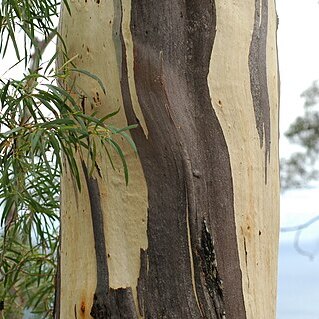Tree to 21 m. Bark smooth throughout, yellow to white and grey. Juvenile leaves linear, green. Adult leaves linear, acuminate or uncinate, thin; lamina 5–10 cm long, 0.2–0.7 cm wide, green; lateral veins faint, at 10°–20°; intramarginal vein up to 1 mm from margin; petiole terete, 4–7 mm long. Umbels with 15 or more flowers; peduncle angular or flattened, 3–8 mm long; pedicels 1–3 mm long. Operculum hemispherical, 1–2 mm long, 2–3 mm wide; hypanthium obconical, 2–3 mm long and wide. Fruits subglobular or subpyriform, 5–6 mm long, 5–7 mm wide; disc broad, level or descending; valves 4, ±level.


